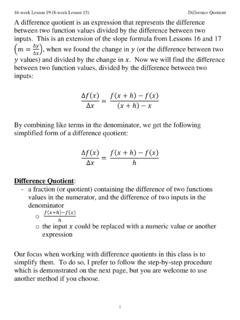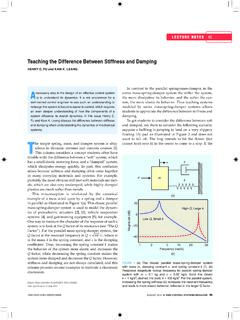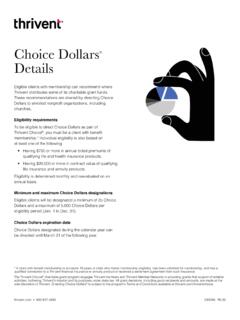Transcription of Differential Amplifier Stages - MIT OpenCourseWare
1 - Microelectronic Devices and Circuits Lecture 19 - Differential Amplifier Stages - Outline Announcements Design Problem -coming out tomorrow; PS #10 looks at pieces; neglect the Early effect in large signal analyses Review -Single-transistor building block Stages Common source: general purpose gain stage , workhorse Common gate: small Rin, large Rout, unity Ai, same Aas CSv Source follower: large Rin, small Rout, unity Av, same Ai as CS Series and Shunt feedback: we'll see in special situations Differential Amplifier Stages -Large signal behavior General features: symmetry, inputs, outputs, biasing (Symmetry is the key!) Large signal transfer characteristic Difference- and common-mode signalsDecomposing and reconstructing general signals Half-circuit incremental analysis techniquesLinear equivalent half-circuits Difference- and common-mode analysisExample: analysis of source-coupled pair Clif Fonstad, 11/17/09 Lecture 19 - Slide 1 IBIAS-V+V123 IBIAS-V+V123 Linear Amplifier layouts: The practical ways of puttinginputs to, and taking outputs from, transistors to form linear amplifiers There are 12 choices: three possible nodes to connect to the input, and for each one, two nodes from which to take an output, and two choices of what to do with the remaining node (ground it or connect it to something).
2 Not all these choices work well, however. In fact only three do: Name Input Output Grounded Common source/emitter 123 Common gate/base 321 Common drain/collector 132 (Source/emitter follower) Source/emitter degeneration 1 2 none Clif Fonstad, 11/17/09 Lecture 19 - Slide 2 IBIASV-V+vout+-vin+-CECOIBIASV-V+vout+-v IN+-COCI Three MOSFET single-transistor amplifiers V+ + IBIAS COvin -+ vout -V-SOURCE FOLLOWER Input: gate Output: source Common: drain Substrate: to source IBIASV-V+vin+-CECO vout+-COMMON SOURCE Input: gate Output: drain Common: source Substrate: to source IBIASV-V+vout+-vIN+-COCICOMMON GATE Input: source; Output: drain Common: gate Substrate: to ground vout + -vin + -vout + -vin + -vout + -vin + -Clif Fonstad, 11/17/09 Lecture 19 - Slide 3 Single-transistor amplifiers with feedbackV+ + vin + CO V+ RF CO + voutvout + --vin --RF IBIASIBIAS CE CE V-V-SERIES FEEDBACK PARALLEL FEEDBACK* vout+-vin+-RFClif Fonstad, 11/17/09 vout+-vin+-RF* Also termed "source degeneracy" Lecture 19 - Slide 4 Summary of the single transistor Stages (MOSFET) !
3 MOSFETV oltagegain, AvCurrentgain, AiInputresistance, RiOutputresistance, RoCommon source"gmgo+gl[]="gmrl'()##ro=1go$ % & ' ( ) Common gate*gm+gmb[]rl'*1*1gm+gmb[]*ro1+gm+gmb+ go[]gt+ , - . / 0 Source followergm[]gm+gmb+go+gl[]*1##1gm+go+gl[ ]*1gmSource degeneracy(series feedback)*"rlRF##*roShunt feedback"gm"GF[]go+GF[]*"gmRF"glGF1GF1"A v[]ro||RF=1go+GF[]$ % & ' ( ) ! Power gain, Ap=Av"AiNote: When vbs = 0 the gmb factors should be deleted. Clif Fonstad, 11/17/09 Lecture 19 - Slide 5 Summary of the single transistor Stages (bipolar) ! BIPOLARV oltagegain, AvCurrentgain, AiInputresistance, RiOutputresistance, RoCommon emitter"gmgo+gl[]="gmrl'()"#glgo+gl[]r$r o=1go% & ' ( ) * Common basegmgo+gl[]=gmrl'()+1+r$#+1[]+#+1[]roE mitter followergm+g$[]gm+g$+go+gl[]+1#glgo+gl[] +#r$+#+1[]rl'rt+r$#+1[]Emitter degeneracy+"rlRF+#+r$+#+1[]RF+roShunt feedback"gm"GF[]go+GF[]+"gmRF"glGF1g$+GF 1"Av[]ro||RF=1go+GF% & ' ( ) * ! Power gain, Ap=Av"AiClif Fonstad, 11/17/09 Lecture 19 - Slide 6 -- Differential Amplifiers: emitter- and source-coupled pairs V+ ++ vOUT1 vOUT2 V+ vOUT1 + -vOUT2 + -IBIAS V-++ ++ vIN2vIN1 vIN2 vIN1 ----IBIAS V-Emitter-coupled pair Source-coupled pair Why do we care?
4 -They amplify only difference-mode signals They are easy to interconnect and cascade They help us eliminate coupling capacitors They are optimally suited to integration Clif Fonstad, 11/17/09 Lecture 19 - Slide 7 IBIASvI1vO1+-vO2+-+-vI2+-+-vO-VSS+VDDRDR DM1M2 Differential Amplifiers: large signal analysis of source coupled pairs Source-coupled pair Below: Schematic with resistor loads Right: Large signal equiv. circuit in saturation Analysis: vI1 - vGS1 +vGS2 -vI2 = 0, vO1 = VDD - RDiD1, vO2 = VDD -RDiD2 KCL at one node: iD1 + iD2 = IBIAS MOSFET relationships: iD1 = K(vGS1-VT)2/2; iD2 = K(vGS2-VT)2/2 (see text for details of analysis) Clif Fonstad, 11/17/09 Lecture 19 - Slide 8 3 KVL loops: Diff. Amps: large signal analysis of source coupled pairs, cont. Results: The outputs again only depend on the difference between the two inputs, (vI1 -vI2): Slope around origin = -gmRD !
5 VO1=VDD"RD2 KvIN1"vIN2[]2+IBIAS +K2vIN1"vIN2[]4 IBIASK"vIN1"vIN2[]2# $ % & % ' ( % ) % vO2=VDD"RD2 KvIN1"vIN2[]2+IBIAS "K2vIN1"vIN2[]4 IBIASK"vIN1"vIN2[]2# $ % & % ' ( % ) % vO="RDK2vIN1"vIN2[]4 IBIASK"vIN1"vIN2[]2 Symmetrical vo Clif Fonstad, 11/17/09 Only the difference in the inputs matters!! Lecture 19 - Slide 9 IBIAS+VCCvI1+-vO1+-vO2+-vI2+--VEE+-vORCR CQ2Q1 Differential Amplifiers: large signal analysis ofemitter coupled pairs Emitter-coupled pair Below: Schematic with resistor loads Right: Large signal equivalent circuit in FAR Analysis: 3 KVL loops: vI1 - vBE1 +vBE2 -vI2 = 0, vO1 = VCC - RC FiF1, vO2 = VCC - RC FiF2 KCL at one node: iF1 + iF2 = IBIAS Ideal diode relationships: iF1 IES exp (qvBE1/kT), iF2 IES exp (qvBE2/kT) (see text for details of analysis) Clif Fonstad, 11/17/09 Lecture 19 - Slide 10 Diff.
6 Amps: large signal analysis of emitter coupled pairs, cont. Results: The outputs only depend on the difference between the inputs, (vI1 -vI2): Slope around origin = -gmRC ! vO1=VCC"#FRCIBIAS1+e"qvI1"vI2()kT[]vO2=V CC"#FRCIBIAS1+eqvI1"vI2()kT[]vO="#FRCIBI AS tanhqvI1"vI2()2kTSymmetrical Clif Fonstad, 11/17/09 Only the difference in the inputs matters!! Lecture 19 - Slide 11 _____ Differential Amplifier Analysis -difference-mode and common-mode signals Any pair of signals can be decomposed into a portion that is the identical in both, and a portion that is equal, but opposite in both. For example, if we have two voltages, v1 and v2, we can define a common-mode signal, vC, and a difference-mode signal, vD, as: vC= (v1+ v2)/2 vD= v1- v2 In terms of these two voltages, we can write v1 and v2 as: v1= vC+ vD/2 v2= vC- vD/2 In incremental analysis of linear amplifiers we will decom-pose our inputs into difference-and common-mode inputs: vic = (vin1 + vin2)/2 and vid = vin1 - vin2.
7 We will apply vid to the circuit and get vod (= Avdvid), and then apply vic to the circuit to get voc (= Avcvic). Then we will reconstruct our outputs: vout1 = voc + vod/2 = Avcvic + Avdvid/2 vout2 = voc - vod/2 = Avcvic - Avdvid/2 Clif Fonstad, 11/17/09 Lecture 19 - Slide 12 Differential Amplifier Analysis -incremental analysis exploiting symmetry and superposition vin1+-vin2+-vout1+-vout2+-Linear equivalentcircuit (symmetrical)vin2+-vout2+-vin1+-vout1+-a LEHC: one halfof sym. LEC a LEHC: one halfof sym. LEC Clif Fonstad, 11/17/09 Lecture 19 - Slide 13 Differential Amplifier Analysis -incremental analysis exploiting symmetry and superposition Clif Fonstad, 11/17/09 Lecture 19 - Slide 14 -vid+--vod+-a LEHC: one halfof sym. LEC vid+-vod+-a LEHC: one halfof sym. LEC No voltage on common links, so incrementally they are +-vod = Avdvid+-a LEHC: one halfof sym. LEC vic+-voc+-a LEHC: one halfof sym. LEC vic+-voc+-a LEHC: one halfof sym.
8 LEC No current in common links, so incrementally they are +-voc = Avcvic+-a LEHC: one halfof sym. LEC Differential Amplifier Analysis -example of LEC analysis Consider a source-coupled pair: IBIAS V-V+ + vi1 + -vo1 -vi2 vo2 We begin by drawing the LEC for this Differential Clif Fonstad, 11/17/09 Lecture 19 - Slide 15 Differential Amplifier Analysis -example, cont. The LEC for our Amplifier : g gmvgs1 go d gsl s,b + -vo1 gel gmvgs2go d gsl vo2gel s,b gcs /2 gcs /2 g ++ vgs1 vgs2vin1 -vin2 -We decompose our inputs into common- and difference-mode inputs: ! vid"vin1#vin2vic"vin1+vin22 Also: ! vod"vout1#vout2voc"vout1+vout22 Clif Fonstad, 11/17/09 Lecture 19 - Slide 16 gmvgsgodgslvid =vgss,bg -+-vodgel+s,b! vod="gmvidgo+gsl+gel()Avd="gmgo+gsl+gel( )From which: Differential Amplifier Analysis -example, cont. gmvgs1 go d gsl vid s,b g + -+ -vod gelvgs1 + -gmvgs2go d gsl -vid s,b g -vodgel vgs2 gcs /2 gcs /2 With vid and -vid inputs: This LEC simplifies to: Clif Fonstad, 11/17/09 Note: We want Avd to be very large.
9 Lecture 19 - Slide 17 Differential Amplifier Analysis -example, cont. gmvgs1 go d gsl vic s,b g + -+ -voc gelvgs1 + -gmvgs2go d gsl vic s,b g vocgel vgs2 gcs /2 gcs /2 ! voc"#gcsvic2gsl+gel()Avc"#gcs2gsl+gel()W ith vic inputs: This LEC simplifies to: From which: gmvgsgodgslvics,bg -+-vodgel+gcs/2vgs -Clif Fonstad, 11/17/09 Note: We want Avc to be very small. Lecture 19 - Slide 18 Differential Amplifier Analysis -example, cont. ! vo1=voc+vod2=Avcvic+Avdvid2="gcs2gsl+gel ()vic"gm2go+gsl+gel()vid="gcs2gsl+gel()v i1+vi2()2"gm2go+gsl+gel()vi1"vi2()! vo2=voc"vod2=Avcvic"Avdvid2="gcs2gsl+gel ()vic+gm2go+gsl+gel()vid="gcs2gsl+gel()v i1+vi2()2+gm2go+gsl+gel()vi1"vi2()Knowin g Avd and Avc, we can construct vo1 and vo2 : Remember: In a good Diff Amp |Avd| is very large, and |Avc| is very small. Clif Fonstad, 11/17/09 Lecture 19 - Slide 19 Looking at a complicated circuit: Lesson I - Find the biasing circuitry and represent it symbolically Consider the following example: Circuitry providing the VREFsIBIAS1 IBIAS3 IBIAS2Q1 ABQ4Q16Q19Q18Q20Q21vOUT+-BvIN2+ V- VAQ7Q6 BvIN1+-+-Q8Q9Q10Q3Q2Q17Q14Q15Q11Q12Q4Q5Q 137 of the 21 transistors are used for biasing the other 14 transistors.
10 If we get the biasing transistors out of the picture for awhile, the circuit looks simpler. (next foil) Clif Fonstad, 11/17/09 Lecture 19 - Slide 20 Looking at a complicated circuit:Lesson II - Identify the individual Stages and their activetransistors and load elements. Actives Continuing with our earlier example, consider the following: Loads follower pairsource Stages Source-coupledpair Push-Pull OutputStage(bipolar) Pair of common-Complementary emitter(pnp and npn) IBIAS1Q18Q20Q21vOUT+-vIN2+ V- VQ7Q6vIN1+-+-Q8Q9Q17Q14Q15Q11Q12Q4Q5Q13 IBIAS3 IBIAS2 Note: We can almost make sense of all of the Stages , but we still need to study active loads and output Stages to fully understand them. Clif Fonstad, 11/17/09 Lecture 19 - Slide 21 Looking at a complicated circuit: Lesson III - Use half-circuit techinques to convert the Differential Stages to familiar single transistor Stages .















